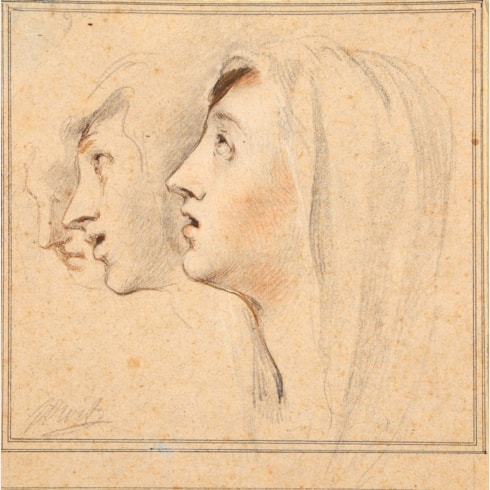Jacob de WIT
(Amsterdam 1695 - Amsterdam 1754)
Self-Portrait, within a Decorative Allegorical Surround
Sold
Pen and brown and grey ink and grey wash, with framing lines in grey ink, laid down on an old mount.
The outlines indented with a stylus for transfer.
144 x 91 mm. (5 5/8 x 3 5/8 in.)
The outlines indented with a stylus for transfer.
144 x 91 mm. (5 5/8 x 3 5/8 in.)
A study, in reverse, for an engraved portrait of Jacob de Wit included in the second volume of Jacob van Gool’s De Nieuwe schouburg der Nederlantsche kunstschilders, published in The Hague in 1751. The print, like most of those reproduced in Gool’s book, is by Jacobus Houbraken (1698-1780). While the elements surrounding the oval portrait are identical in the both the drawing and the print, the portrait itself is not, and it appears that Houbraken substituted another likeness of the artist for the portrait in the present drawing. Indeed, the margin of the print lists Jan Maurits Quinkhard as the author of the portrait (‘J.M. Quinkhard pinx. 1751.’) and Jacob de Wit as responsible for the decorative surround (‘J. de Wit orn. del.’), alongside Houbraken as the printmaker (‘J. Houbraken sculp.’). The portrait in the Houbraken print is also very similar, albeit in reverse, to an etched portrait of Jacob de Wit by J. L. Benoist the Younger.
Jacob de Wit produced a variety of painted and drawn self-portraits, all of which show the artist at approximately the same age, and with his head and shoulders in variants of the same pose. Among these is one closely related to the present sheet; a pen and wash drawing in the collection of the Rijksmuseum in Amsterdam. Somewhat larger in scale, the Rijksmuseum drawing is close to the present sheet in composition, incorporating the same oval portrait but flanked by a putto in a different pose, and with alternative attributes of the arts underneath.
Another self-portrait drawing by Jacob de Wit, drawn in black and red chalk, is in the Stiftung Weimarer Klassik und Kunstsammlungen in Weimar, while another is in the P. and N. de Boer Foundation in Amsterdam. A similar painted oval self-portrait of c.1740 is in the Museum Ons’ Lieve Heer op Solder in Amsterdam.
An impression of the Houbraken engraving (see related image) is sold with this drawing.
Jacob de Wit produced a variety of painted and drawn self-portraits, all of which show the artist at approximately the same age, and with his head and shoulders in variants of the same pose. Among these is one closely related to the present sheet; a pen and wash drawing in the collection of the Rijksmuseum in Amsterdam. Somewhat larger in scale, the Rijksmuseum drawing is close to the present sheet in composition, incorporating the same oval portrait but flanked by a putto in a different pose, and with alternative attributes of the arts underneath.
Another self-portrait drawing by Jacob de Wit, drawn in black and red chalk, is in the Stiftung Weimarer Klassik und Kunstsammlungen in Weimar, while another is in the P. and N. de Boer Foundation in Amsterdam. A similar painted oval self-portrait of c.1740 is in the Museum Ons’ Lieve Heer op Solder in Amsterdam.
An impression of the Houbraken engraving (see related image) is sold with this drawing.
Jacob de Wit was a pupil of Albert van Spiers in Amsterdam before moving to Antwerp in 1708, at the age of thirteen, to live with his uncle, a wealthy merchant and art collector. He studied there with Jacob van Halle and also made copies after the work of Rubens, Van Dyck and other Flemish painters. De Wit was back in Amsterdam by 1715 or 1716, and soon became one of the leading artists in the city, with a particular reputation as a painter of decorative wall murals, ceiling paintings and overdoors for the town and country houses of wealthy merchants and patricians in Amsterdam. A Catholic, he was one of the few talented artists in Amsterdam in the 18th century to produce a significant body of paintings of religious subjects, in which the influence of Rubens was paramount. De Wit was given several commissions for altarpieces and large religious works, notably a very large painting of Moses Selecting the Seventy Elders for the Town Hall in Amsterdam, painted between 1735 and 1737. He was also particularly regarded for his grisaille paintings, in imitation of marble or stucco reliefs, which came to be popularly known as ‘witjes’ after the artist. Despite his success, he did not have a large studio with many assistants.
Jacob de Wit worked almost entirely in Amsterdam and never travelled abroad. As such he is perhaps better known, at least outside Holland, as a draughtsman than as a painter. At the time of his death, the contents of his studio contained between 2,500 and 3,000 drawings, which were dispersed at auction in Amsterdam in March 1755. (As his biographer Adolph Staring noted, ‘The immense quantity of studies and sketches from the sale of his atelier and of finished drawings made for collectors spread more readily over the western world than his paintings...and consequently De Wit is much better known as a draughtsman than as a painter. The printrooms of Amsterdam, Berlin, Brussels, Frankfort, Leyden, Haarlem, Paris and Vienna have assembled instructive series of different types of his drawings.’
Provenance
Louis Meier, Cecil Court, London
Purchased from him in c.1956 by Ralph Holland, Newcastle
Thence by descent until 2013.
Literature
Hans Buijs and Ger Luijten, ed., Goltzius to Van Gogh: Drawings and Paintings from the P. & N. de Boer Foundation, exhibition catalogue, Paris, 2014-2015, pp.220-221, under no.100 (entry by Robert-Jan te Rijdt).
Exhibition
Newcastle upon Tyne, Hatton Gallery, Old Master Drawings, From the XVIth to the XIXth century, 1960, no.63.







